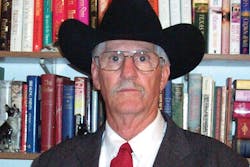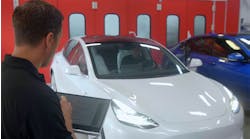Bob Smith first became interested in the automotive industry as a teenager who loved drag racing. After graduating from the University of Missouri, he met a friend who shared his enthusiasm for drag racing and who introduced him to the independent appraisal industry. Smith began to work as a senior adjustor for Shelter Insurance Co. in Kansas City and became involved with trade associations such as the Collision Industry Conference, AMI, ASA, and the Society of Collision Repair Specialists. He thrived on seeking fairness within the industry and soon developed a passion for legislative issues. Now, Smith is a registered lobbyist for the states of Missouri and Kansas and has been instrumental in passing bills directed at improving both the consumer’s and collision repair industry’s position in the repair process. The owner of Storm Appraisal & Management Service Inc. says doing the right thing always meant becoming an advocate for these two parties. Here, Smith explains the focus of his work, some of the biggest legislative issues facing the industry right now and how he envisions the future of collision repair.
As a lobbyist for the states of Missouri and Kansas, who do you work for?
Under the corporate structure, I represent the Missouri Collision Coalition and the Kansas Collision Coalition. The MCC & KCC are made up of not only the major associations in each state but also individual collision repair facilities and corporations which believe in the advancement of initiatives on behalf of not only the consumer but also the collision repair industry.
What are you hoping to accomplish?
We initially started out by trying to help collision repairers develop relationships with state agencies, such as the insurance commissioner’s office, that could handle some of their issues. This, naturally, led to working with legislative issues.
I am trying to get the industry to realize that if it presents a united front to legislators it can be a considerable force that must be heard. David can take on Goliath and win. This, in turn, gives collision repair business an equal footing with other businesses. The industry must also realize this takes time and commitment, which requires adequate funding.
It costs dollars to have a legislative presence, but if you break it down, it takes less money to do this than a shop will lose in one day’s time from inaction, which results in customers not being properly reimbursed for damages. It also does not cost a repair facility to be involved by giving input and standing up to be counted.
What can the rest of the country learn from what you’re doing in Missouri & Kansas?
Quite simply put, I hope they learn that there is a professional way they can voice opposition on issues and deal in such a way with them that will not completely alienate the collision industry to those who do not see these issues the same way. I really don’t think we are doing anything special in Missouri and Kansas that cannot be done in other states.
The legislative process is not a light switch answer by any means. It is a tedious, slow process and sometimes seems to accomplish very little, but when you take the small victories and add them up, they amount to important decisions for the collision industry. Again, repairers need to realize that they will lose more net income by not having a presence at the state capitol in a single day than they will in a week of worrying about the minor fluctuations in an estimate or an adjuster not including something. It may not be as tangible as a shortage of some labor unit, but it is just as real.
What do you see as the single biggest issue facing the collision repairers today?
Survival. I would further define that to the survival of independent collision repair facilities. I have always ignored the statement that we have an overabundance of collision repair shops for the amount of work actually being presented for repair, but it is a fact. Unfortunately, there are definitely more repair facilities than needed. Frequency is down on a year-to-date basis (with a couple small increases) and has been on an ever-decreasing slide for several years now. This is causing shops to do things to get a share of the available work to the point some are doing work at a loss and expecting to make the business profitable.
The downside of all this is that there are quality repair shops that will be summarily eliminated by the economic process (assuming it is left alone by the insurance industry). Quality independent shops, and even some of the consolidators, are going to be hitting the economic bottom shortly. Narrow margins and too much interference in the business by third parties are the main factors in both cases. The legitimate collision repair industry has to get over being its own worst enemy and it must do this in a big hurry if it is expected to survive.
What are some things shop owners can work on to improve the industry?
Marketing themselves is one of the first. The collision industry, as a whole, has never been known for its marketing ability. With the advent of preferred programs, marketing has become the exception rather than the norm. The shop that survives now will be the one that can find a niche and market that niche and itself to the customer.
Another is that the repair facility must remember that the vehicle owner is its one and only customer, not XYZ Mutual. You can ask 100 shops what they do best and you will get at least 90 answers like this one: “I fix cars well.” This is simply the wrong answer. The thing they do or should do best is market their business and themselves to the vehicle owner. It should be a given that they repair vehicles properly.
The other things shop owners can do to improve the industry is to simply run their businesses like businesses. The only thing a shop may defend in court, or to anyone else, is what repairs and/or processes they actually perform on the vehicle. State clearly on your appraisal exactly what you intend to do on a vehicle and then do everything you say. Your estimate and your final invoice should be a road map of the repair done. Most management systems will print a final invoice based on what actions your shop performed. The thing to note here is the statement “what actions your shop performed” and not what some insurance estimate or appraiser told you they would pay for. The shop and only the shop, according to insurance spokesmen, is the final expert authority on repairs and parts. Insurers insist that they only pay for repairs. How are you going to defend anything else lawfully? You and only you are the responsible party for the repairs.
In one word, how would you describe the state of the industry and why?
“Evolving.” The collision industry has changed so much over the past five years and the change is gaining momentum. Is it good or is it bad? Only time will tell and the answer will be different for most everyone. We have to remember that a lot of the things we see today and some to come are because we, as an industry, asked for them. Remember the saying, “Be careful what you ask for as you may just get it”? Well, some of the things we see right now are things I remember industry leaders screaming for at the top of their lungs only a few years ago. Now they are screaming just as loud because they got what they thought they wanted.
I have said many times and will say it again: We are our own worst enemies. We are fragmented, apathy is rampant, and collision repairers are plainly beat up. Most refuse to get involved in the corrective and restorative processes. The saying “Let George do it” has never been more common than in this industry. Of course, an economy with $4.00 gasoline and large financial institutions failing certainly doesn’t help. Don’t look now, but the government is not going to bail us out. We are going to have to do that for ourselves.
How do you envision the future of collision repair?
I guess I am a romantic because I still believe there is a place for the professional, independent collision repairer, even in this day of insurers migrating toward bigger, one-stop shops and less personal contact with the people they do business with. Even the entitlement generation has those who like to do business with a live person.
We have already said that there will be fewer facilities and these will have requirements that we have never had in the past—in the form of technology, training, equipment and materials—not to mention an ever-increasing demand for free services and concessions by insurers. In the near future, we will see certification and/or licensing as a requirement because of the complexity of these vehicles.
I am certainly not trying to paint the industry with gloom and doom. Quite the contrary, for those who find their niche and are of the younger generations, the industry, as it evolves, can hold a great and profitable future. We can gain back control of our businesses and still deal rationally and realistically with insurers. We must always remember that our only true customer is the vehicle owner and tailor our business to fill their needs and expectations of us. We must learn what the customer wants and reach them with the message that we are there to provide those services and are responsible to them as vehicle owners. As an industry, we must stand firm on doing what is needed to properly repair the vehicle and then do what we say.



